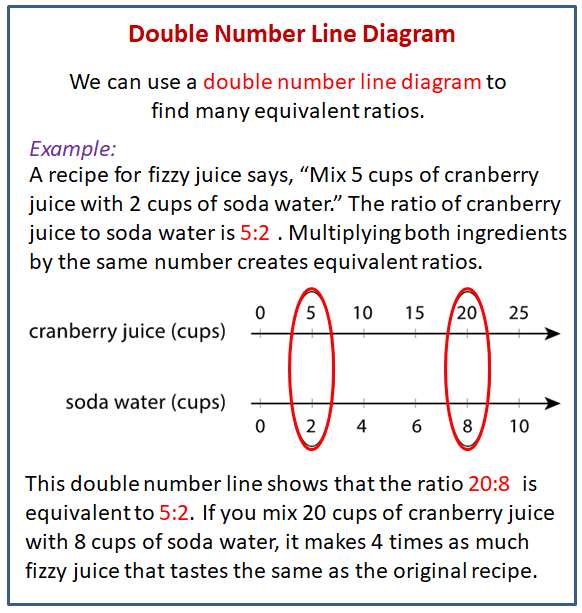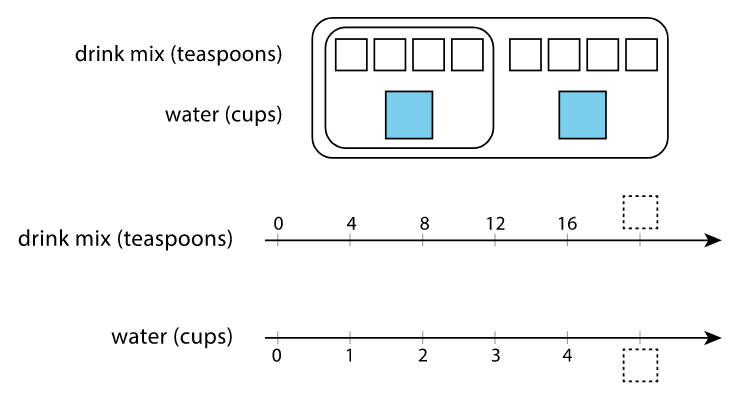Illustrative Mathematics Unit 6.2, Lesson 6: Introducing Double Number Line Diagrams
Learning Targets:
- I can label a double number line diagram to represent batches of a recipe or color mixture.
- When I have a double number line that represents a situation, I can explain what it means.
Related Pages
Illustrative Math
Grade 6
Lesson 6: Introducing Double Number Line Diagrams
How to use double number lines to represent equivalent ratios?
Illustrative Math Unit 6.2, Lesson 6 (printable worksheets)
Lesson 6 Summary
The following diagram shows how to use a double number line diagram to find equivalent ratios and solve word problems.

6.1 Number Talk: Adjusting Another Factor
Find the value of each product mentally.
(4.5) • 4
(4.5) • 8
1/10 • 65
2/10 • 65
6.2 - Drink Mix on a Double Number Line
The other day, we made drink mixtures by mixing 4 teaspoons of powdered drink mix for every cup of water. Here are two ways to represent multiple batches of this recipe:
- How can we tell that 4:1 and 12:3 are equivalent ratios?
- How are these representations the same? How are these representations different?
- How many teaspoons of drink mix should be used with 3 cups of water?
- How many cups of water should be used with 16 teaspoons of drink mix?
- What numbers should go in the empty boxes on the double number line diagram? What do these numbers mean?
Recall that a perfect square is a number of objects that can be arranged into a square. For example, 9 is a perfect square because 9 objects can be arranged into 3 rows of 3. 16 is also a perfect square, because 16 objects can be arranged into 4 rows of 4. In contrast, 12 is not a perfect square because you can’t arrange 12 objects into a square.
- How many whole numbers starting with 1 and ending with 100 are perfect squares?
- What about whole numbers starting with 1 and ending with 1,000?
6.3 - Blue Paint on a Double Number Line
Here is a diagram showing Elena’s recipe for light blue paint.
- Draw a double number line diagram to show the amounts of white paint and blue paint in different-sized batches of light blue paint.
- Compare your double number line diagram with your partner. Discuss your thinking. If needed, revise your diagram.
- How many cups of white paint should Elena mix with 12 tablespoons of blue paint? How many batches would this make?
- How many tablespoons of blue paint should Elena mix with 6 cups of white paint? How many batches would this make?
- Use your double number line diagram to find another amount of white paint and blue paint that would make the same shade of light blue paint.
- How do you know that these mixtures would make the same shade of light blue paint?
Glossary Terms
double number line diagram
A double number line diagram uses a pair of parallel number lines to represent equivalent ratios. The locations of the tick marks match on both number lines. The tick marks labeled 0 line up, but the other numbers are usually different.
Lesson 6 Practice Problems
- A particular shade of orange paint has 2 cups of yellow paint for every 3 cups of red paint. Draw a double number line and circle the numbers of cups of yellow and red paint needed for 3 batches of orange paint.
- This double number line diagram shows the amount of flour and eggs needed for 1 batch of cookies.
a. Complete the diagram to show the amount of flour and eggs needed for 2, 3, and 4 batches of cookies.
b. What is the ratio of cups of flour to eggs?
c. How much flour and how many eggs are used in 4 batches of cookies?
d. How much flour is used with 6 eggs?
e. How many eggs are used with 15 cups of flour?
3. Here is a representation showing the amount of red and blue paint that make 2 batches of purple paint.
a. On the double number line, label the tick marks to represent amounts of red and blue paint used to make batches of this shade of purple paint.
b. How many batches are made with 12 cups of red paint?
c. How many batches are made with 6 cups of blue paint?
The Open Up Resources math curriculum is free to download from the Open Up Resources website and is also available from Illustrative Mathematics.
Try out our new and fun Fraction Concoction Game.
Add and subtract fractions to make exciting fraction concoctions following a recipe. There are four levels of difficulty: Easy, medium, hard and insane. Practice the basics of fraction addition and subtraction or challenge yourself with the insane level.

We welcome your feedback, comments and questions about this site or page. Please submit your feedback or enquiries via our Feedback page.



